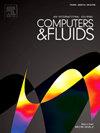不可压缩 (D)DES Spalart-Allmaras 湍流模型的连续临界点
IF 3
3区 工程技术
Q3 COMPUTER SCIENCE, INTERDISCIPLINARY APPLICATIONS
引用次数: 0
摘要
本文以 Spalart-Allmaras 湍流模型为基础,针对不可压缩分离涡模拟(DES)和延迟分离涡模拟(DDES)模型控制的流体流动,提出了基于梯度的形状优化连续临界法。由于这两种流动模型本质上都是非稳态的,因此在对非稳态邻接方程进行逆向时间积分时,流场的可用性就成了难题。为了最大限度地降低计算成本和内存需求,使用作者最近开发的 iPGDZ+ 有损压缩技术对计算流场进行了压缩。该技术在湍流解析流中的应用是本文的第二个原创性贡献,因为在湍流解析流中,流场压缩是一个复杂的挑战。一切都作为 OpenFOAM 中公开可用的 adjointOptimisation 库的扩展来实现,该库用于求解流动和 adjoint 方程并进行优化。利用外部空气动力学中的两个形状优化问题,证明了将湍流模型方程的临界点纳入计算精确灵敏度导数至关重要。在 "冻结湍流 "假设下计算的敏感度忽略了设计变量变化引起的湍流粘度变化,与之相比,所提出的邻接法得到的敏感度与使用有限差分法得到的敏感度一致。这要归功于 "思考-离散-连续"(Think-Discrete Do-Continuous adjoint)方法,该方法受手工微分离散邻接法(hand-differentiated discrete adjoint)的启发,为连续邻接法推导出的方程中涉及的项提供了一致的离散化方案。此外,研究还证明,所提出的邻接法能显著受益于 iPGDZ+ 算法,它能将内存需求减少两个数量级以上,无需进行流重新计算,同时还能保持计算导数的精度。处理这类流量模型目标函数大积分窗口的方法不在本文讨论范围之内。本文章由计算机程序翻译,如有差异,请以英文原文为准。
The continuous adjoint to the incompressible (D)DES Spalart-Allmaras turbulence models
This article formulates the continuous adjoint method for the gradient-based shape optimization of fluid flows governed by the incompressible Detached Eddy Simulation (DES) and Delayed-DES (DDES) models, based on the Spalart-Allmaras turbulence model. As both flow models are inherently unsteady, challenges arise regarding the availability of flow fields during the backward in time integration of the unsteady adjoint equations. To minimize both the computational cost and the memory demands, the computed flow fields are compressed using the iPGDZ lossy compression technique, recently developed by the authors. Its application in the context of turbulence-resolving flows, where the compression of flow fields poses an intricate challenge, is a second original contribution of this article. Everything is implemented as an extension to the publicly available adjointOptimisation library of OpenFOAM, which is used to solve the flow and adjoint equations and conduct the optimization. Using two shape optimization problems in external aerodynamics, it is demonstrated that including the adjoint to the turbulence model equation is crucial for the computation of accurate sensitivity derivatives. In contrast to sensitivities computed under the “frozen turbulence” assumption, which neglects variations in turbulent viscosity due to changes in the design variables, the proposed adjoint method yields sensitivities that align with those obtained using Finite Differences. This is due to the Think-Discrete Do-Continuous adjoint method which, inspired by hand-differentiated discrete adjoint, gives rise to consistent discretization schemes of the terms involved in the equations derived by continuous adjoint. Furthermore, it is demonstrated that the proposed adjoint method can significantly benefit from the iPGDZ algorithm, by reducing memory requirements by more than two orders of magnitude, eliminating the need for flow recomputations, while maintaining the accuracy of the computed derivatives. Ways to handle large integration windows of the objective function with this type of flow models are beyond the scope of this article.
求助全文
通过发布文献求助,成功后即可免费获取论文全文。
去求助
来源期刊

Computers & Fluids
物理-计算机:跨学科应用
CiteScore
5.30
自引率
7.10%
发文量
242
审稿时长
10.8 months
期刊介绍:
Computers & Fluids is multidisciplinary. The term ''fluid'' is interpreted in the broadest sense. Hydro- and aerodynamics, high-speed and physical gas dynamics, turbulence and flow stability, multiphase flow, rheology, tribology and fluid-structure interaction are all of interest, provided that computer technique plays a significant role in the associated studies or design methodology.
 求助内容:
求助内容: 应助结果提醒方式:
应助结果提醒方式:


